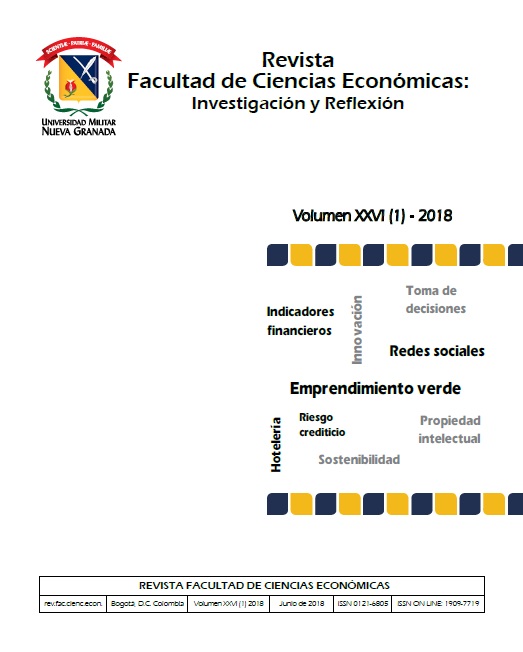Semiparametric analysis of factors associated to enterprises sustainability análisis semiparametrico de los factores asociados a la sostenibilidad de los emprendimientos
Abstract
This article, a research product, aims to identify and analyze the factors that determine the sustainability of the enterpreneurships, evidencing the relevance of the individual and crossed effects, related to the entrepreneur, entrepreneurship and the environment, in the Subregion of Bajo Cauca - Colombia, for which a quantitative methodology was addressed through a semi-parametric model. We used a sample of 101 entrepreneurs, 73 active and 28 inactive. The main contribution of this research is to determine the degree to which each variable, of those identified for the study -elaboration of the business plan, location, indebtedness, diversification of the offer and legal form-, individually and in interaction with others, affects the survival of the enterpreneurships.Downloads
References
Allison, P. (1984) Event history analysis. Londres: Sage Publications. https://doi.org/10.4135/9781412984195
Aranguren, M. J., Larrea, M. & Pe-a, I. (1999). Incubadoras: ¿Supervivencia y Crecimiento de Nuevas Empresas?. Encuentro de Economía Aplicada, Reus. 1-27.
Arias, A., Jung, A. & Pe-a, I. (2007). Factores asociados al cese de actividades de nuevas firmas espa-olas. Cuaderno de Economía, Uruguay, Departamento de Economía, Facultad de Ciencias Empresariales, Universidad Católica del Uruguay II (2), 7-21
Arias, A. & Quiroga, R. F. (2008). Cese de actividades de las pymes en el área metropolitana de Cali (2000-2004): un análisis de supervivencia empresarial. Cuaderno Administración Bogotá, XXI (35), 249-277.
Baumol, W. J. (1996). Entrepreneurship : Productive, Unproductive and Destructive. Journal of Business Venturing, 11 (1): 3-22. https://doi.org/10.1016/0883-9026(94)00014-X
Bird, B. (1989). Entrepreneurial Behavior. Scott, Foresman and Company. En: Glenview (IL). BIS.
Boden, R. J. & Nucci, A. R. (2000) On the survival prospects of men's and women's new business ventures. Journal of Business Venturing, XV (4), 347–362. Disponible: http://doi.org/10.1016/S0883-9026(98)00004-4.
Bracke, P., Hilber, C. & Silva, O. (2015). Mortgage debt and entrepreneurship (Bank of England working papers). En: Bank of England. Retrieved from, https://ideas.repec.org/p/boe/boeewp/0560.html.
Cámara de Comercio de Medellín para Antioquia. (2013). Permanencia Empresarial en Antioquia en el período 2000-2012. Revista Antioque-a de Economía y Desarrollo RAED, ed. (6): 45-85
Campbell, C. A. (1992). A decision theory model for entrepreneurial acts. Entrepreneurship: Theory and Practice. p. 21-28.
Canedo, J., Stone, D., Black, S. & Lukaszewski, K. (2014). Individual factors affecting entrepreneurship in Hispanics. Journal of Managerial Psychology, 29 (6): 755-772. https://doi.org/10.1108/JMP-11-2012-0333
Casson, M. (1983). The Entrepreneur- An Economic Theory. Albro Business History Review. 570-572
Cooper, A. C., Woo, C. Y. & Dunkelberg, W. C. (1989) Entrepreneurship and the initial size of firms. Journal of Business Venturing, IV (5): 317–332, Disponible: http://doi.org/http://dx.doi.org/10.1016/0883-9026(89)90004-9.
Cox, D. R. (1972). Regression Models and Life-Tables. Journal of the Royal Statistical Society. Series B (Methodological), XXXIV (2), 187–220. Disponible: http://doi.org/10.2307/2985181.
Cuervo, Á., Ribeiro, D. & Roig, S. (2007). Entrepreneurship: Conceptos, Teoría y Perspectiva. Revista de la Universidad de Valencia. https://doi.org/10.1007/978-3-540-48543-8
Fertala, N. (2008). The shadow of death: do regional differences matter for firm survival across native and immigrant entrepreneurs?. Empirica, XXXV (1), 59-80. https://doi.org/10.1007/s10663-007-9051-2
Flores-Luna, C, M., Mu-oz, S. Z., Salazar-Martínez, E. & Lazcano-Ponce, E. (2000). Análisis de supervivencia. Aplicación en una muestra de mujeres con cáncer cervical en México. Salud pública de México, 42 (3), 242–251. https://doi.org/10.1590/S0036-36342000000300011
Gartner, W. B. (1988). "Who is an Entrepreneur?" Is the Wrong Question. Educational Foundation, 11-32.
Groszkowski, T. & Stryjewski, T. (2015). The Econometric Analysis of Entrepreneurship Determinants in Polish Voivodeships in the Years 2004–2013. Dynamic Econometric Models. 15, 157-165. https://doi.org/10.12775/DEM.2015.008
Ha, N. (2012). The effect of growth on firm survival in vietnam. Depocen Working Paper Series, 18.
Iturriaga, M., Baniandrés, J. & Eizaguirre, A. (2016) Del emprendimiento individual a la capacidad emprendedora de nuestras organizaciones: un análisis de los factores que la definen. Boletin de estudios económicos. LXXI (217): 49-69
Jung, A. & Pe-a, I. (2004). Factores asociados al fracaso de nuevas empresas. En: III Conferencia Internacional de Investigadores en Emprendedurismo de América Latina, Rio de Janeiro, 56-68.
Kaplan, E, & Meier, P. (1958). Nonparametric estimation from incomplete observations. Journal of the American Statistical Association, LIII (282), 457-481. https://doi.org/10.1080/01621459.1958.10501452
Katz, J. A. (1992). A Psychosocial Cognitive Model of Employment Status Choice. Entrepreneurship: Theory y Practice, 29-37.
Lau, T. & Chan, K. F. (1994). The Incident Method - An Alternative Way of Studying Entrepreneurial Behaviour. Irish Business and Administrative Research. 15: 48
Martínez, A. F. (2006). Determinantes de la supervivencia de empresas industriales en el área metropolitana de Cali 1994-2003. Revista Sociedad y Economía. (11), 112-144.
Marulanda, J. A., Correa, G. & Mejía, L. F. (2009). Emprendimiento: Visiones desde las teorías del comportamiento humano. Revista EAN, (66): 153-168.
Mas-Verdú, F., Ribeiro-Soriano, D. & Roig-Tierno, N. (2015). Firm survival: The role of incubators and business characteristics. Journal of Business Research, 68(4), 793–796. http://doi.org/DOI: 10.1016/j.jbusres.2014.11.
Moriano, J. A., Trejo, E. & Palací, F. J. (2001). El Perfil Psicosocial del Emprendedor: Un estudio desde la perspectiva de los valores. Revista de Psicología Social, (16): 229-242. https://doi.org/10.1174/021347401317351152
Noguera, M., Alvarez, C., Merigó, J. & Urbano, D. (2015). Determinants of female entrepreneurship in Spain: an institutional approach. Computational and Mathematical Organization Theory. 21 (4): 341-355. https://doi.org/10.1007/s10588-015-9186-9
Parra, J. F. (2011). Determinantes de la probabilidad de cierre de nuevas empresas en Bogotá. Revista Facultad de Ciencias Económicas: Investigación y Reflexión, XIX (1), 27-53.
Pereira, F. & Medina, L. (2012). Global Entrepreneurship Monitor -GEM-Antioquia 2012-2013. Colombia: Ediciones Sello Javeriano.
Perinat, A. (1980). Contribuciones de la Etología al Estudio del Desarrollo Humano y Socialización. El Basilisco, (11): 27-34.
Phillips, B. & Kirchhoff, B. (1989). Formation, Growth and Survival; Small Firm Dynamics in the U.S. Economy. Small Business Economics, I (1), 65-74. https://doi.org/10.1007/BF00389917
Rajasekaran (2013). Sustainable Entrepreneurship: Past Researches and Future Directions. Journal of Entrepreneurship and Management, 2 (1): 20-27.
Reynolds, P. D., Carter, N. M., Gartner, W. B. & Greene, P. G. (2004). The Prevalence of Nascent Entrepreneurs in the United States: Evidence from the Panel Study of Entrepreneurial Dynamics. Small Business Economics, (23), 263-284. https://doi.org/10.1023/B:SBEJ.0000032046.59790.45
Rocha, V., Carneiro, A. & Amorim Varum, C. (2015). Serial entrepreneurship, learning by doing and self-selection. International Journal of Industrial Organization, 40: 91–106. http://doi.org/10.1016/j.ijindorg.2015.04.001
Rodriguez, A. (2009). Nuevas perspectivas para entender el emprendimiento empresarial. Pensamiento y Gestión, (26): 94-119.
Ronstadt, R. S. (1984). Entrepreneurship: Text, Cases and Mites. Lord Publishing, Dover (MA).
Schaltegger, S. & Wagner, M. (2011). Sustainable Entrepreneurship and Sustainability Innovation: Categories and Interactions. Business Strategy and the Environment Business, (20): 222-237.
Sepulveda, C. & Reina, W. (2015). Sostenibilidad de los emprendimientos: Un análisis de los factores determinantes. Revista Venezolana de Gerenecia (23), 33-49
Shane, S. & Venkataraman, S. (2000). The Promise Of Entrepreneurship As A Field Of Research. Academy of Management Review, (25), 217-227. https://doi.org/10.5465/AMR.2000.2791611
Simon, V. M., Revuelto L.T. & Medina, A. F. (2012). La influencia de la formación, la experiencia y la motivación para emprender en la supervivencia de las empresas de nueva creación. Estudios gerenciales, XXVIII, (Edición especial), 237-262.
Stuart, R. W. & Abetti, P. A. (1990). Impact of entrepreneurial and management experience on early performance. Journal of Business Venturing, V (3), 151–162, Disponible: http://doi.org/http://dx.doi.org/10.1016/0883-9026(90)90029-S.
Tavassoli, S. & Jienwatcharamongkhol, V. (2016). Survival of Entrepreneurial Firms : The Role of Agglomeration. Externalities Papers in Innovation Studies. CIRCLE, (October)
Taymaz, E; Köksal, M. (2006). El espíritu emprendedor, el tama-o de lanzamiento y la supervivencia de los peque-os empresarios. En: Ekonomiaz: Revista vasca de economia, (62): 70-99.
Tinbergen, N. (1963). On Aims and Methods of Ethology. Department of Zoology. Revista University of Oxford, 20: 410-433.
Turkina, E. & Thi, M. T. (2015). Socio-psychological determinants of opportunity entrepreneurship. International Entrepreneurship and Management Journal, 11 (1): 213-238 https://doi.org/10.1007/s11365-013-0288-x
Wompner, F. (2008). Educación superior para el emprendimiento. Expansiva. Serie indagación 19.
Yeasmin, N. (2016). The Determinants of Sustainable Entrepreneurship of Immigrants in Lapland: En Analysis of Theoretical Factors. Entrepreneurial Business and Economics Review, 4(1): 129-159.











